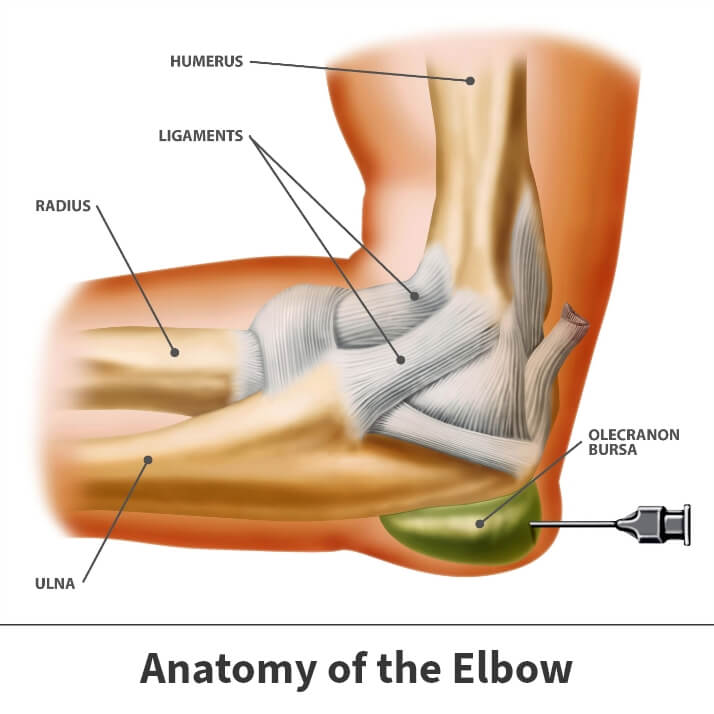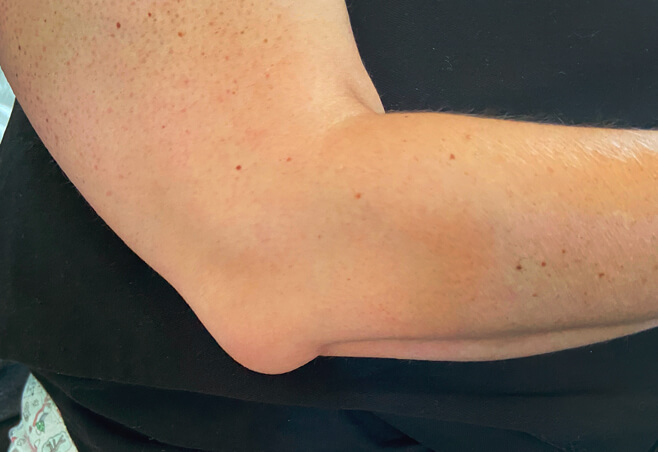Elbow bursitis
Elbow bursitis is a condition that results in the small, lubricating, fluid-filled pouch in the elbow (the bursa), to overfill with fluid and swell, resulting in pain. This condition can be caused by prolonged pressure, trauma, infection, or a pre-existing medical condition. There are both surgical and non-surgical options available to eliminate symptoms and get you back to your daily activities. Non-surgical are the most common and are typically successful. Depending on the severity of your condition, surgical procedures may be necessary with most people making a full recovery in a few weeks.
Anatomy

The elbow joint is where the upper arm bone (humerus) meets the two forearm bones (radius and ulna). The bony point of the elbow is called the olecranon and is located at the upper end of the ulna. This joint consists of several muscles, ligaments, nerves, and tendons, and is both a pivot and hinge joint, meaning it allows you to bend and straighten, as well as twist and rotate your arm. It is also positioned directly under the elbow skin and so has very little protection by muscles or other soft tissues.
There are many bursae located throughout the body, including the elbow, that act as cushions between bones and soft tissues. They contain a small amount of lubricating fluid that allows the soft tissues, like your skin, to move freely over the underlying bone.
About
Elbow bursitis, also known as olecranon bursitis, happens when the olecranon bursa, a thin, fluid-filled sac located in the boney tip of the elbow, becomes irritated or inflamed, resulting in fluid build-up.
Several factors can cause elbow bursitis, including:
- Prolonged pressure – Leaning on the elbow on hard surfaces for extended periods can cause the bursa to swell. Certain professions can put you at a higher risk of getting elbow bursitis, such as plumbers or heating and air conditioning technicians who frequently lean on their elbows and crawl on their knees.
- Trauma – A hard blow to the tip of the elbow can cause the bursa to produce extra fluid and swell.
- Infection – If an injury, like a puncture wound, at the tip of the elbow breaks the skin, bacteria can get into the body and the elbow bursa sac, causing infection. When the bursa gets infected, it will produce fluid, get red and swell, resulting in pain.
- Medical conditions – Certain conditions, like gout and rheumatoid arthritis, can be associated with elbow bursitis.

Symptoms
The symptoms associated with elbow bursitis are:
- Swelling – The first symptom of elbow bursitis is usually swelling. Swelling may not be noticeable right away because of the loose skin at the back of the elbow.
- Redness and warm to the touch – If the bursa is infected, the surrounding skin will become red and warm. If the infection is not treated immediately, it can potentially spread to other parts of the arm and even get into the bloodstream, resulting in a more serious illness.
- Pain – As the swelling and fluid build-up gets worse, the bursa stretches, resulting in pain. The direct pressure on the bursa from bending the elbow makes the pain worse.
Diagnosis
Your Florida Orthopaedic Institute physician will first take a look at your symptoms and medical history and then perform an examination of your arm and elbow. From there, your physician may order some tests to confirm your diagnosis. These tests can include:
- X-rays – Patients who have had repeated instances of elbow bursitis are at a high risk of also developing bone spurs. An X-ray may be ordered to make sure you do not also have bone spurs.
- Fluid testing – Your physician may choose to take a small sample of bursal fluid to determine whether the bursitis is caused by infection or not. This test uses a needle to collect fluid for testing.
Treatment
There are both non-surgical and surgical treatments available to help get you to make a full recovery from elbow bursitis. Your Florida Orthopaedic Institute physician will first recommend non-surgical treatments. If your elbow bursitis does not improve, surgery may be necessary.
Nonsurgical treatments
If your physician determined that your bursitis was caused by an infection, they would perform a nonsurgical procedure known as bursa aspiration. A bursa aspiration is a removal of the fluid in the bursa using a needle. Fluid removal helps relieve symptoms and gives your physician a fluid sample that can be tested and used to determine if an antibiotic is needed to eliminate an infection.
If the bursitis is not caused by an infection, several other non-surgical treatment options can help eliminate symptoms, including:
- Elbow pads – An elbow pad may be prescribed to cushion and reduce pressure on the elbow.
- Medications – Advil/Motrin (ibuprofen) or other anti-inflammatories such as Aleve may be used to reduce swelling and relieve your symptoms.
- Activity changes – Activities that put pressure on the elbow should be avoided. This prevents the elbow bursitis from getting worse and allows the swelling to subdue.
Surgical treatments
Regardless of whether the elbow bursa is infected or not, if it does not respond to nonsurgical treatments, the surgical treatment most frequently used for elbow bursitis is the removal of the entire bursa. This procedure is typically performed as an outpatient procedure, meaning you leave the surgery center after the procedure is over.
Physical therapy
Although physical therapy is not necessary after the procedure, your physician may recommend specific exercises to do at home to help improve your range of motion. Additionally, your skin should heal within 12 to 16 days after surgery. After 3 to 4 weeks, your elbow should be back to normal.
Videos
Related specialties
- Arthroscopic Debridement of the Elbow
- Aspiration of the Olecranon Bursa
- Cubital Tunnel Syndrome
- Elbow Injuries & Inner Elbow Pain in Throwing Athletes
- Golfer's Elbow
- Growth Plate Injuries of the Elbow
- Hyperextension Injury of the Elbow
- Little Leaguer's Elbow (Medial Apophysitis)
- Olecranon Stress Fractures
- Radial Tunnel Syndrome
- Tennis Elbow Treatment
- Tricep Pain & Tendonitis
- UCL (Ulnar Collateral Ligament) Injuries
- Valgus Extension Overload
